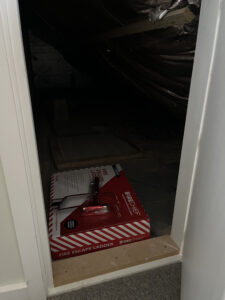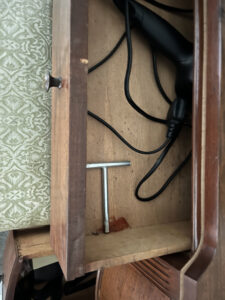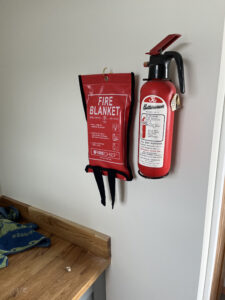Property Details:
- Address: Holmefield, Scalby Road, YO13 0NL, Main House
- Type of Property: Residential, 2-Story House
- Number of Bedrooms: 4
- Construction Type: Brick, Clay Tile Roof, Silicone Render
- Year Refurbished: 2024
- Occupants: Max 20
Guests are responsible for adhering to property rules and operating house equipment safely and responsibly.
Fire Escape Plan
Evacuation Plan Overview
In the event of a fire, it’s critical that all occupants know how to quickly and safely escape the home. This plan provides clear guidance on escape routes and actions to take in a fire emergency.
Primary Exit Routes
The primary exit routes should be the main staircase (if safe) and an alternative escape route for the second story:
Ground Floor:
- Main Exit: The front or back door is the primary exit from the ground floor.
- Alternative Exit: Sliding doors and windows can serve as a secondary exit in case the main door is blocked by fire.
First Floor:
- Main Exit: The main staircase is the primary exit from the first floor, and this is protected by a fire door, separating it from the kitchen. Proceed down the stairs and out the sliding doors. Please ensure keys to the sliding doors are kept in the door at all times.
- Alternative Exit: If escape down the main staircase is not safe, there is an emergency ladder in the master bedroom that can be used to escape via the opening Velux windows. If the Velux windows are not accessible, a glass breaking tool is provided to break the glass of a larger bedroom window. See pictures below.
First Floor Window Escape Plan
- Each bedroom should have a clear path to the windows (remove any furniture or obstructions).
- Emergency Escape Ladder: The fire escape ladder is stored in the master bedroom crawl space. The key to the crawl space is in the drawer of the wooden vanity (see pictures below).
- Usage Guidelines:
- Open the window and extend the ladder.
- Begin descending one person at a time, ensuring a safe, slow descent.
- Never allow multiple people to use the ladder at once to avoid overloading it.
- Usage Guidelines:
Family Meeting Point
- After evacuation, meet your party at the end of the driveway.
- Ensure everyone in the household is familiar with the location.
- If someone is missing or trapped, report the exact location to the fire department immediately.
Emergency Procedures
- Sound the Alarm:
- As soon as the fire is detected, activate smoke alarms and call 999.
- Alert all occupants to evacuate immediately.
- Evacuate Quickly and Safely:
- Ground Floor Occupants: Exit the building via the main door or a secondary exit.
- First Floor Occupants: Use the main staircase or exit through a secondary escape route (via emergency ladder).
- If Escape via Ladder is Not Possible:
- If a person on the second floor is unable to use the ladder due to mobility issues or if the ladder fails to deploy, signal for help using a phone, flashlight, or waving a cloth at the window.
- Stay low in smoke-filled areas and cover your nose and mouth with a cloth or mask.
- Use of Fire Extinguishers:
- If it’s safe, and the fire is small or contained in a specific area (like the kitchen), use a fire extinguisher to suppress the flames.
- Only use fire extinguishers if the fire is manageable and if you can exit the house easily afterward.
Fire Safety Equipment
- Smoke Alarms:
- Smoke alarms are installed on each level of the home.
- They are tested regularly.
- Fire Escape Ladder:
- A fire escape ladder is available on the first floor. You can find this in the crawl space of the master bedroom.
- A glass hammer is available on the first floor. You can find this in the crawl space of the master bedroom.
- Fire Extinguishers:
- A fire extinguisher is available in the utility room, next to the kitchen.
- Teach everyone in the household how to operate a fire extinguisher (using the PASS method: Pull, Aim, Squeeze, Sweep).
- A fire blanket is available in the utility room, next to the kitchen.
- Fire Doors:
- Fire doors are fitted to protect escape routes
- Emergency Flashlights:
- Flashlights are available in the kitchen, under the sink and in the drawers by the wine fridge.
Special Considerations
- Children, Elderly, or Disabled Family Members or Guests: Ensure they are given priority during the evacuation and have assistance to reach the loft window or other exits.
- Pets: Plan for the safe evacuation of pets, if possible, and have a designated person responsible for them during the escape.
Post-Escape Procedures
- Once everyone is safely outside, do not re-enter the building until emergency personnel have declared it safe.
- Contact emergency services to inform them of any people or pets still inside the house.
- Gather at the pre-determined family meeting point and ensure all members are accounted for.
Locations of fire equipment:
This is location of the fire escape ladder and hammer, in the crawl space of the master bedroom on the first floor:
This metal key, in the top drawer of the vanity, just to the left of the crawl space, will open the crawl space door:
On the ground floor, you will find a fire extinguisher and fire blanket hung in the utility room.
Fire Risk Evaluation
Potential Fire Hazards
- Kitchen: Presence of cooking equipment (stoves, ovens, microwaves), high-risk area for fire due to cooking practices.
- Electrical Appliances: Risk of electrical fires from malfunctioning appliances (toasters, dryers, dishwashers, etc.), and overloading of sockets.
- Heating Equipment: Risk associated with central heating systems, portable space heaters, or the wood-burning stove. Misuse could lead to fire.
- Candles & Open Flames: Candles or any open flames used for decoration or ambiance, especially near combustible materials like curtains. These are not permitted at Holmefield.
- Wood-burning Stove: Holmefield is fitted with a wood-burning stove. Please operate the stove safely and do not leave a fire unattended.
- Flammable Liquids: Presence of flammable liquids (cleaning agents, oils, etc.) stored inappropriately or near heat sources.
- Smoking: Cigarettes or cigars discarded improperly, especially around flammable materials like furniture, bedding, and trash.
Risk Control & Prevention Measures
- Kitchen Safety:
- Install smoke alarms and heat detectors in or near the kitchen.
- Ensure that a fire extinguisher (appropriate for grease fires) is easily accessible.
- Keep flammable materials (cloth, paper towels) away from cooking areas.
- Never leave cooking unattended.
- Electrical Safety:
- Regular inspection of all electrical wiring, outlets, and appliances.
- Ensure that extension cords are not overloaded, and unplug appliances when not in use.
- Hire a qualified electrician for routine checks and repairs.
- Avoid running cords under rugs or in high-traffic areas.
- Heating Equipment Safety:
- Service the central heating system annually.
- Keep flammable materials away from portable heaters and fireplaces.
- Use fireguards when using the stove.
- Candles & Open Flames:
- Never leave a fire in the stove unattended.
- Please use the provided metal bucket for ashes. Only dispose of ashes when the stove has completely cooled, as hot ashes can cause fires.
- Open flames are not permitted. Battery operated candles are provided.
- Storage of Flammable Materials:
- Store flammable liquids (cleaning supplies, paints) in a cool, dry place, away from any heat sources.
- Do not store these materials in areas like the garage or near boilers, heaters, or stoves.
- Smoking Safety:
- Establish designated smoking areas away from the home, with proper disposal of cigarette butts in fireproof containers.
- Smoking is not allowed indoors.
Emergency Response Plan
- First Response:
- In case of a fire, call 999 immediately and provide details of the fire’s location.
- If the fire is small and manageable, use a fire extinguisher or fire blanket to contain it.
- Evacuation Plan:
- In the event of a significant fire, evacuate immediately.
- Do not re-enter the building until authorities give the all-clear.
- Fire Safety Training:
- Ensure all occupants are familiar with the fire safety equipment and emergency protocols.
- Educate everyone on how to react in the event of a fire.
- Record Keeping and Maintenance
- Routine Inspections:
- We check smoke alarms every month to ensure they are working.
- We inspect the condition of fire extinguishers every 6 months.
- We clean and service heating equipment annually.
- We check electrical systems for signs of wear or malfunction regularly.
- Maintenance Log:
- We maintain a log for inspections, servicing of fire safety equipment, and repairs to ensure compliance with safety measures.
- Risk Evaluation and Mitigation
Risk Level: Low to Moderate
- The primary concerns are related to the kitchen area, electrical systems, and heating equipment.
- The risk can be minimized with proactive fire prevention measures, regular maintenance, and the installation of proper fire safety equipment.
Review Date: Feb 2025
This assessment provides an overview of the fire risks in the home and outlines the necessary safety measures and precautions.


